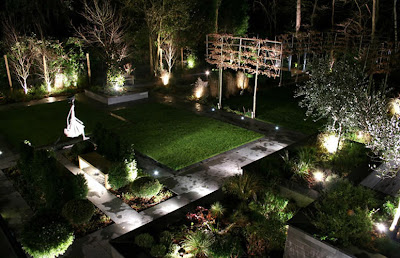Garden Lighting Design
October 18, 2010
1.Think About the Areas That you Consider Need Lighting
2. Deciding Exactly How You Want the Exterior lighting to Work?
Washing
Shadowing
Crosslighting
Downlighting
Moonlighting
Path / Step lighting
Uplighting
Uplighting can be achieved in various ways by placing lights at ground level. Two effective ways are by placing a light at the base of a tree to wash up the trunk into the canopy or to illuminate a garden building or rear/front house elevation.
Water lighting
HINTS!!
Things visible during the day can be left in darkness, so you have the opportunity to make dramatic changes to your visible landscape. Less really is more. Shadow is as important to your scheme as light, so don’t try to light everything. Instead, retain some mystery. Also, keep it subtle! Very bright garden lighting can look brash and artificial.
Good areas and features to concentrate on:- Dining & seating areas, walkways, sculptures, water features, pots, specimen planting, trees, architectural features, garden features, buildings, etc can all be highlighted in a garden to create wonderful, varied ‘textures’ of light.
2. Deciding Exactly How You Want the Exterior lighting to Work?
Uplighting, down lighting, mid-level lighting, step lighting, etc?
You may want to take into consideration how the garden will be used and how the garden will be viewed from the house. Also, consider security aspects, lighting can deter unwanted intruders! Consider how the lights are going to be ‘switched on’ – exterior switch or interior switch? How many lights are required to be switched on at any one time? If you require some areas of the lighting to be separate from others you will require different lighting ‘circuits’. You may want to consider ‘remote control’ lighting, whereby the lighting can be operated with a small keyfob, as opposed to using a switch. Do you require ‘sensors’?
LIGHTING EFFECTSYou may want to take into consideration how the garden will be used and how the garden will be viewed from the house. Also, consider security aspects, lighting can deter unwanted intruders! Consider how the lights are going to be ‘switched on’ – exterior switch or interior switch? How many lights are required to be switched on at any one time? If you require some areas of the lighting to be separate from others you will require different lighting ‘circuits’. You may want to consider ‘remote control’ lighting, whereby the lighting can be operated with a small keyfob, as opposed to using a switch. Do you require ‘sensors’?
Washing
By placing the light at the base of a wall or hedge the light 'washes' over the surface creating a soft glow effect. However this can also be achieved by 'lifting' the light at certain angles to wash the desired area eg. Patio area.
Shadowing
This is achieved by placing the light in front of the object you wish to illuminate. Depending on how high the light fitting is secured will depend on how dramatic the shadow will appear.
Crosslighting
This effect can be very appealing as the subject is lit from two sides, which not only highlights the feature but also softens it at the same time.
Downlighting
Downlighting is useful to pick out a particular plant or feature. This is also useful for creating interest with shadows etc. This can also be employed as a 'security' effect, to light doorways/entrances or for general luminance where entertainment may take place.
Moonlighting
This is a very romantic and effective way of using lighting. This effect requires the positioning of a light in a tree for instance. The ray of light is broken up to reveal a dappled effect on the ground. This can be applied in other areas but a tree is often the best way.
Path / Step lighting
The idea of path / step lighting is to create interest and a desire to 'go and see' what is further down the trail. A good reason for this method of lighting is to make the pathway safe.
Uplighting
Uplighting can be achieved in various ways by placing lights at ground level. Two effective ways are by placing a light at the base of a tree to wash up the trunk into the canopy or to illuminate a garden building or rear/front house elevation.
Water lighting
By placing a light in water it wonderful effects can be achieved. Moving water is especially appealing with every ripple being enhanced by the light. Using lights in the water to focus on a fountain or feature is also possible and the light fitting can be concealed under the water.
HINTS!!
Things visible during the day can be left in darkness, so you have the opportunity to make dramatic changes to your visible landscape. Less really is more. Shadow is as important to your scheme as light, so don’t try to light everything. Instead, retain some mystery. Also, keep it subtle! Very bright garden lighting can look brash and artificial.
Avoid glare - When it comes to garden lighting try to angle the light beams away from your lines of sight. Where this isn’t possible, frosted lenses, glare guards, and hex cell louvers can reduce dazzle.
Placing lights near plants - If you’re installing lights in winter, remember that your herbaceous plants will be growing over spring and summer. Try to avoid placing lights where they will be swamped by foliage. Experiment with lighting effects - Try throwing shadows onto walls, creating reflections in ponds, or using backlighting to create interesting silhouettes.







